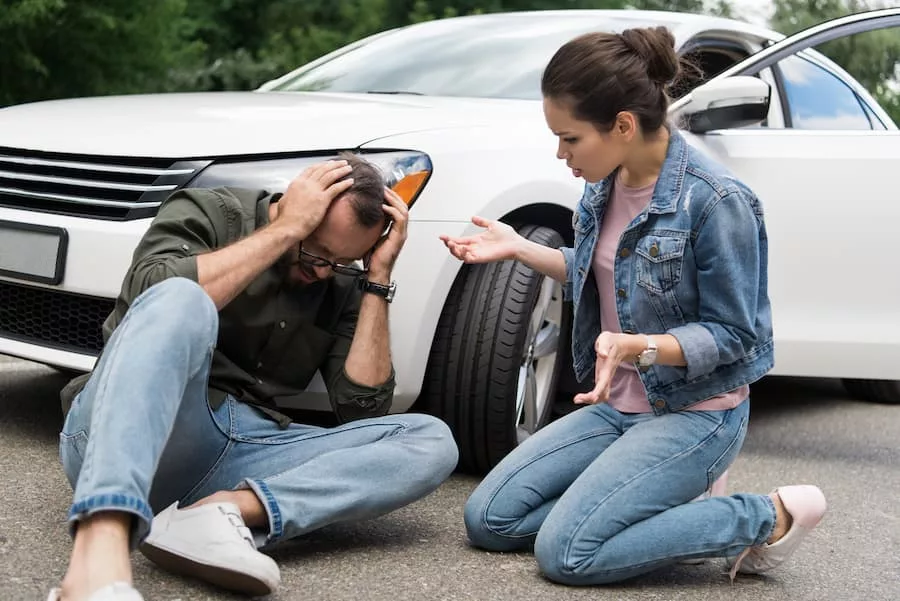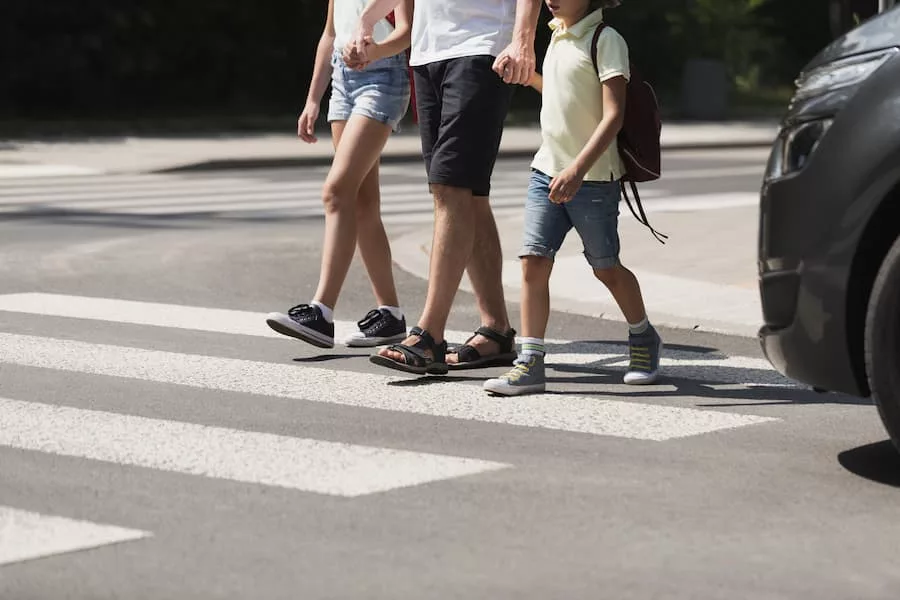If you suffered an injury in a pedestrian accident someone else caused, you have likely incurred significant medical expenses. Who is going to pay for them? If the accident was not your fault, why should you have to carry that burden?
How Much Do Pedestrian Accidents Cost?
According to a study published in the Association for the Advancement for Automotive Medicine, the average cost per case for a pedestrian-motor vehicle collision is $135,558. Based on injury severity, the average cost per case ranges from $4,460 for minor injuries to $791,751 for severe injuries to $2.8 million for fatal injuries. These estimated figures include medical costs, lost productivity, and quality of life losses.
Most people do not have that much money available to apply toward their medical expenses after a pedestrian accident. Therefore, pedestrian accident victims need to know their options for seeking compensation.
Who Covers Medical Expenses After a Pedestrian Accident?
Who is responsible for your considerable medical expenses if you suffered injuries in a pedestrian accident? Depending on the facts and circumstances of your case, you might be able to obtain compensation for your medical expenses from one or more of these sources:
The Pedestrian’s Personal Injury Protection Insurance
Florida requires drivers of motor vehicles with at least four wheels to maintain personal injury protection (PIP) insurance. PIP insurance covers the injured policyholder regardless of who causes an accident, any members of the policyholder’s household, and any passengers in the policyholder’s vehicle who do not have their own PIP insurance. It also covers the policyholder when they get injured in accidents that occur outside their vehicle, such as a pedestrian accident.
Therefore, your first source of compensation after a pedestrian accident might be your own PIP insurance if you have an auto insurance policy at the time of the accident.
Unfortunately, PIP insurance only covers 80 percent of the policyholder’s necessary and reasonable medical expenses and 60 percent of lost income up to the policy minimum of $10,000. Many pedestrian accident expenses far exceed $10,000, especially when injuries are severe.
If you do not have PIP insurance or your expenses exceed your policy minimum, you may have other options for seeking compensation.
The Driver’s Car Insurance
If you do not have your own PIP insurance, the driver’s PIP policy should cover you as a pedestrian. Furthermore, if your medical expenses exceed PIP policy limits, you might be eligible to pursue compensation from the at-fault driver’s state-required liability insurance policy.
For the at-fault driver to be liable for your injuries, those injuries must meet the severity threshold established by the Florida legislature, which define a serious injury as:
- Significant or permanent disfigurement or scarring
- Significant or permanent loss of use of a bodily function
- Death
A personal injury attorney can advise whether your case meets this threshold and effectively argue that they do.
One potential challenge you might face is that of the uninsured motorist. According to the Insurance Information Institute, 20.4 percent of Florida drivers lack the state-required car insurance. That means there’s a one-in-five chance that the driver who hit you has no insurance.
Uninsured/underinsured motorist coverage typically covers policyholders who get injured in pedestrian accidents where the at-fault party has no insurance. If you do not have UM/UIM coverage, you may have to pursue other options for seeking compensation from the at-fault driver.
The Driver, Through a Lawsuit
If the driver does not have insurance, or if their insurance provider denies your claim or attempts to minimize your payout, you can demand the full compensation you deserve by filing a lawsuit against the driver.
An experienced car accident attorney can pursue your case on your behalf, preparing it for trial while negotiating for a settlement. If the liable parties will not make a fair offer, your attorney will go to court and argue your case in front of a judge or jury, explaining how the driver caused the accident and why they owe you compensation.
The Pedestrian’s Health Insurance
An injured pedestrian can also utilize their own health insurance to cover medical expenses such as doctor’s appointments and surgery. This insurance helps injured pedestrians defray costs while they pursue liability claims or lawsuits, and protects those deemed at fault for their injuries. However, it also has several limitations.
First, most health insurance policies have co-pays and deductibles that can be quite costly depending on the policy. According to the Kaiser Family Foundation, a nonprofit organization focused on national health issues, the average annual deductible for employer-based health insurance plans is $2,004 for a single employee and $3,868 for a family. Coming up with an unanticipated several thousand dollars in deductibles in a pedestrian accident would be a hardship for most people.
Second, most health insurance policies limit which doctors their enrollees can see to get the full benefit available. The financial consequences of seeing an out-of-network doctor can be significant. If your injuries require the care of an out-of-network specialist, you could face thousands of dollars in out-of-pocket expenses that your own health insurance will not cover. You could face other limitations when using your health insurance benefits, such as your provider covering only a specific number of physical therapy sessions.
Third, if your employer provides your health insurance, your coverage depends upon your continued employment. Because pedestrian accidents often result in catastrophic injuries that may prevent you from returning to work, you could eventually find yourself without health insurance. Losing your employment and the related insurance benefits could be especially problematic if your injuries require long-term treatment.
Who Else Could Cause a Pedestrian Accident?
In many cases, a negligent driver causes a pedestrian accident. In some cases, other liable parties cause or contribute to pedestrian accidents. By investigating every potentially responsible party, pedestrian accident victims can determine every potential source of compensation and maximize the amount of money they could recover.
Depending on the facts of your case, you may pursue compensation from the following entities after a pedestrian accident:
- A negligent driver. Examples of negligent actions by drivers include distracted driving, driving under the influence of drugs or alcohol, speeding, disobeying traffic lights, and failing to yield to pedestrians.
- The driver’s employer. If the negligent driver was working at the time of the accident, you might hold their employer accountable for your injuries. Employers share liability for the negligent actions of their employees.
- A government agency. You may hold a government agency accountable if its negligence contributes to an accident. For example, if an inoperable traffic light caused a pedestrian-vehicle collision, the injured pedestrian might pursue damages from the government agency.
- The vehicle manufacturer. If a vehicle malfunction causes a pedestrian accident, the injured victim might attempt to obtain compensation from the vehicle’s manufacturer.
Common Injuries Suffered in Pedestrian Accidents
Pedestrian accidents can result in various injuries. Some of those injuries can be catastrophic or life-threatening.
Injuries commonly suffered in pedestrian accidents include:
- Broken bones. Pedestrians can suffer broken bones in their arms, legs, pelvis, ribs, and other areas of the body, particularly if the vehicle that hits them is traveling at a high rate of speed.
- Head injuries. Pedestrians typically lack any protection for their head when a vehicle strikes them, which makes them vulnerable to head injuries, such as concussions or more severe traumatic brain injuries.
- Back injuries. Pedestrians can suffer back injuries, such as herniated discs, fractured vertebrae, or spinal cord injuries. In the worst circumstances, back injuries can result in partial or total paralysis.
- Internal injuries. Internal injuries, such as organ damage or internal bleeding, might occur when a vehicle hits a pedestrian.
- Soft tissue injuries. Pedestrians can suffer injuries to their soft tissues, including muscles, ligaments, or tendons, in a wreck with a vehicle.
- Lacerations and abrasions. Pedestrians can experience lacerations from flying debris, shattered glass, or contact with the vehicle. Abrasions, such as road rash, can occur when a struck pedestrian makes contact with gravel or pavement or the vehicle drags the person along the road.
- Emotional trauma. Pedestrian accidents can traumatize the victim, leaving them with anxiety, depression, or post-traumatic stress disorder. These conditions could require short-term psychological care or even ongoing treatment for years.
Common Medical Expenses After a Pedestrian Accident
Medical expenses from pedestrian accidents vary depending on the diagnosis and severity of the injuries.
Typical expenses incurred by pedestrian accident victims include:
- Emergency medical care. Ambulance transportation, emergency room care, and diagnostic tests, such as X-rays, CT scans, or MRIs, all belong to this category.
- Hospitalization. If the pedestrian’s injuries are severe, they may require hospitalization to receive surgery, intensive care, and monitoring of their condition.
- Rehabilitation. Pedestrian accident victims may require rehabilitative care to regain mobility, strength, and function. Rehabilitative care could include physical therapy, occupational therapy, and other rehabilitation services.
- Physician care. An injured pedestrian may need to see a doctor or specialist for ongoing treatment, such as wound care, pain management, or treatment for complications.
- Medical equipment and supplies. A pedestrian accident victim may require medical equipment and assistive supplies, such as crutches, braces, or a wheelchair, to aid in their recovery.
- Medication. The pedestrian will likely require prescription medication to alleviate the pain from their injuries or treat other conditions.
- Mental health care. The injured pedestrian may require counseling or other mental health services or treatment to help them cope with the accident’s aftermath.
How a Letter of Protection Can Help Pay Medical Bills
Health and PIP insurance can blunt the high cost of your medical expenses, but they have their limitations. And if you do not have health insurance, you could soon find yourself struggling with considerable medical bills that aren’t your fault. How can you come up with the money to pay these bills now while waiting for your claim to settle or your lawsuit to conclude?
A letter of protection (LOP) can help you pay for the care you need while you pursue compensation for your injuries. Written and signed by a personal injury attorney, a LOP provides a guarantee to medical providers that the patient will pay their medical bills once they resolve their case, either from a settlement or judgment award.
This document allows an injured victim to receive necessary medical treatment without worrying about the costs upfront, which can be a significant burden after a pedestrian accident. A LOP is a legally binding document, so you should not try to write one yourself. A personal injury attorney can write a legally sound LOP that protects your rights and interests.
How Big a Problem Are Pedestrian Accidents in Florida?
Pedestrian accidents are a grave and significant problem in Florida. According to a report from the Governors Highway Safety Association, Florida had the nation’s second-highest number of pedestrian accident fatalities in one recent year. That year, 899 pedestrians lost their lives in accidents. When accounting for population, Florida ranks second in the national pedestrian fatality rate, with 4.13 deaths per 100,000 people. That is almost double the national rate of 2.26 per 100,000 people.
According to a report from Smart Growth America, seven of the top 20 most dangerous metropolitan areas for pedestrians in the United States are in Florida. The Miami-Fort Lauderdale-Pompano Beach area ranks number 14, with 954 pedestrians dying in accidents over a five-year period.
What Happens if the Insurance Company Denies a Pedestrian Accident Claim?
Because insurance companies prioritize their profits, they look for any excuse to deny a pedestrian accident claim. If your claim gets rejected, you should seek legal advice about your options.
A personal injury attorney can help you explore your legal options and strengthen your claim. For example, they may investigate the case and uncover additional evidence that either refutes the insurance company’s reasons for denial or supports your claim. They may also advise you to consider filing a lawsuit to pursue compensation at trial. A lawsuit requires completing many complex, lengthy, and adversarial processes, so work with a lawyer with trial experience.
Pedestrian Accident Victims Can Seek Compensation for Injuries
If you suffered an injury in a pedestrian accident, you might be eligible to seek compensation for your medical expenses from a variety of sources. You do not deserve to incur significant medical treatment costs when someone else injured you.
Related articles
Related articles Related articles Related articles Related articles Related articles Related articles Related articles Related articles Related articles Related articles
Pedestrian Accident
15 May 2023
How Long Do Pedestrian Accident Claims Take To Settle?
Pedestrian Accident
12 May 2023
Can a Pedestrian Be at Fault For a Car Accident?





